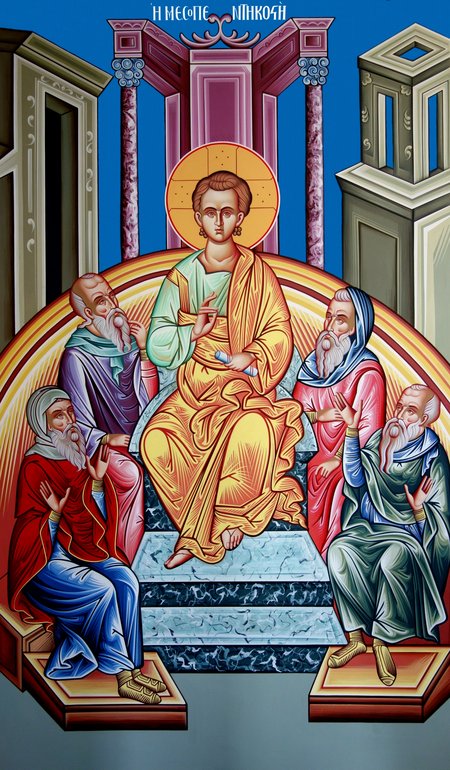|
«Ἁγία Σοφία» - “Holy Wisdom”
On
February 1, 2021 His Eminence Archbishop Benjamin of San Francisco and
the West officially established Holy Wisdom Mission in Grand Junction,
Colorado.
The
name of our parish, Holy Wisdom, refers specifically to our Lord, God,
and Savior Jesus Christ as we know from Holy Scripture.
Saint
Paul writes that Jesus is “Christ the power of God, and the wisdom
of God” (1 Corinthians 1:24). And he
also states that Christ Jesus became for us “Wisdom from God, and
Righteousness, and Sanctification, and Redemption”
(1 Corinthians 1:30).
Since
all Orthodox churches are dedicated to our Savior Jesus Christ, very
few are designated solely in His name. Most churches additionally
commemorate a Great Saint of the Christian faith, many honor the
Theotokos, and some memorialize a Great Feast in the life of our Lord.
Because
of the ineffable glory of God, if a church is to exclusively
commemorate the Lord, it is not given the specific name of Jesus
Christ Himself, but rather is named after one of His attributes such
as Savior or Wisdom.
This
honor is generally, but not always, reserved for the most-significant
cathedral churches. For example, the cathedral of Moscow, Russia, is
named “Christ the Savior.” The cathedrals of Constantinople and Kiev are named
“Agía Sofía” – “Holy Wisdom.”
Ἁγία
Σοφία, pronounced Agía Sofía, does not mean “Saint Sofia” but,
rather, Holy Wisdom. The great church in Constantinople, built in AD
537 by Emperor Justinian (AD 482-565, reigned 527-565), is not
called Saint Sofia but “Holy Wisdom” – or, more specifically, the
“Great Church of Christ the Holy Wisdom.”
Churches
named Holy Wisdom annually celebrate their feast day on the Wednesday
of Mid Pentecost. Sadly, few Christians today know about this great
feast of the Lord. It was once one of the most-beloved feasts and was
celebrated in Constantinople by the Patriarch, the Emperor, and crowds
of the faithful.
The
fifty-day period following Pascha until the Pentecost is known as the
Pentecostarion. On the twenty-fifth day, the mid-point between Pascha
and Pentecost, we focus on the central theme of the period: the
acquisition of the Holy Spirit poured out as a gift to all the
faithful who partake of the Living Water which is Christ Himself.
The
Gospel for the Feast of Mid Pentecost is the account of Jesus teaching
the elders in the Temple, “sitting in the midst of the teachers ...
and all who heard Him were astonished at His understanding and
answers” (Luke 2:46-47).
The
hymns for this Feast invoke, and praise, our Lord as the “Wisdom of
God” spoken of in the Book of Proverbs. They also recognize Him as the
One of Whom the Prophet Isaiah says, “And the Spirit of God shall
rest upon Him, the spirit of wisdom and understanding, the spirit of
counsel and strength, the spirit of knowledge and godliness.”
(Isaiah 11:2-3).
Icons of Christ, the “Holy Wisdom” of the Father

The
principal icon of Jesus Christ, the Word and Wisdom of the Father, is
that for the Feast of Mid Pentecost. In it we see Jesus seated in the
Temple of Jerusalem listening to, asking questions of, and answering
the teachers (cf. Luke 2:41-50).
Icons
are not pictures of people and events, but theological expressions
about them. In the New Testament Christ is referred to as the icon
(image, projection, reflection) of God the Father
(cf. 2 Corinthians 4:4, Colossians 1:15, Hebrews 1:3).
Man himself was created as an icon of God (Genesis 1:27)
called to become like Him (Genesis 1:26).
This
icon shows elements of the historical event, a young Christ seated in
a group of mature and learned men, who seem surprised at the wisdom of
His questions and His answers, as the Biblical account describes.
Click the icon to enlarge...
The
Lord is depicted holding a scroll with one hand while the other hand
is in a gesture of making a point. The men are shown in a state of
amazement and conferring with one another. The semi-circular seating
arrangement is also found in the Icon of Pentecost, indicating that
this Mid Pentecost prefigures the coming of the Holy Spirit at
Pentecost.
Christ
is portrayed without a beard as He was twelve years old at the time.
This represents Christ as Emmanuel, “God with us,” teaching that
Christ is the Wisdom and Word of God incarnate.
Sometimes
Mary and Joseph are shown in the background of the icon, for they had
returned to Jerusalem to find Him. This indicates not only their
concern, but also reminds us that “He went down with them and came to
Nazareth, and was subject to them” (Luke 2:51).

There
is another iconographic composition developed in the northern Russian
city of Novgorod during the 15th century to convey the understanding
of Jesus Christ as “Holy Wisdom.”
In
this icon, “Wisdom” is represented by a red-faced, winged angel
sitting on a throne in the center of the image. The throne is
supported by the seven Old Testament pillars of wisdom
(cf. Proverbs 9:1). The red color
represents the fire of divinity, and the icon of Jesus located above
shows Him in both His conventional aspect and in His aspect of Holy
Wisdom.
Click the icon to enlarge...
|

